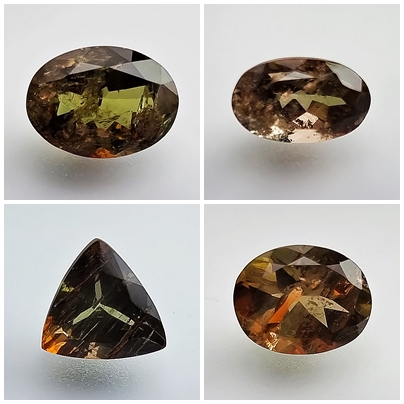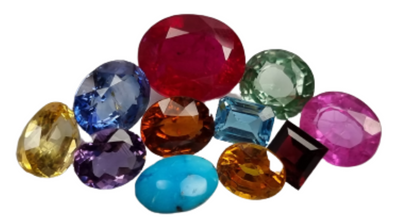
Andalusite: Gemstone Information
Andalusite colors range from a greenish brown to a rich green in color, the stones owing much of their attractiveness to their pleochroism which shows as red, yellow and green colors. The mineral is, with kyanite and sillimanite, a polymorph of Al2SiO5. While the crystals, members of the orthorhombic system, have a prismatic habit with vertically striated prisms which are nearly square in section and capped with pyramids, most gem material is found as water-worn pebbles.
The hardness of andalusite is 7.5 on Mohs’ scale and the SG varies from 3.15 to 3.17. The least and greatest RIs vary from 1.634 to 1.641 and 1.644 to 1.648, the biaxial negative, DR varying from 0.007 to 0.011. The pleochroic colors are yellow, green and red which may vary in intensity. The absorption spectrum varies: a deep green variety, believed to come from Brazil, and in which occupies the octahedral Al site, shows a manganese spectrum with an absorption band, graded in intensity, which ends in a knife-sharp edge at 553.5 nm and which is accompanied by fine lines at 550.5 and 547.5 nm and fainter ones at 518 and 495 nm.
There is a strong absorption in the blue and violet but a band at 455 nm can just be seen. This has been noted in the normal types of gem and alusite and these stones, particularly those from Sri Lanka, show this band to be accompanied by a narrow band at 436 nm. These last two bands are probably due to iron. Andalusite exhibits no luminescenceunder LWUV but the brownish greenstones from Brazil often show a dark green to yellowish green glow under SW and greenish yellow under X-rays. While andalusite of a dull green is found in the gem gravels of Sri Lanka, Brazil is a more common source of the gem material, where the stones are found in secondary deposits, either on the stream bedsor on the slopes of the hills under several yards of clay and gravel.
This is in an area some 15 km wide and 40 km in length near the town of Santa Tereza in the state of Espirito Santo. Andalusite is also found in the state of Minas Gerais. The gem mineral is rarely found in crystals with good form and most of the gemmy material is found as water-worn pebbles. The Brazilian stones usually show a very strong flesh-red and olive-green pleochroism, which is especially well brought out when the stones are cut with the table facet nearly at right angles to the vertical axis of the crystal.
Such stones may closely resemble certain types of Brazilian tourmalines. A dark green andalusite is also found in Brazil and so too are stones of a rose-red color, although these are rare. The opaque variety of andalusite in which the crystals, cut across their length, display carbonaceous inclusions in the form of a cross is known as chiastolite. Sections are cut and polished for amulets and charms in several countries, and particularly in the Pyrenees.
Owing to impurities chiastolite may have a lower hardness and SG than transparent crystals. Chiastolite crystals are found in the Nerchinsk district of Transbaikalia in Siberia, at Sallas de Rohan near Brieux in Brittany, France, and Mount How den, north of Bimbowrie in South Australia. Other localities are at Hof in the Fichtelgebirge, Bavaria, Germany, and in the slates around Skiddaw in Cumberland, England, but here the needle-like prisms are too slender for fashioning into gems. Sources in the USA are Arizona, and Madera in Madera County, California. Other localities are in Maine, Connecticut, Massachusetts and New Mexico, and Fannin County, Georgia. Good examples of the chiastolite variety are found in the Chantaing U range, near Kyankse, south of Mandalay, in Myanmar and Zimbabwe.
Unveiling the Enigmatic Andalusite Gemstone: A Precious Revelation
Andalusite, with its mystical allure and captivating beauty, stands as a testament to the wonders of the natural world. Originating from the Spanish province of Andalusia, this remarkable gemstone has fascinated civilizations for centuries with its unique properties and metaphysical significance. In this comprehensive guide, we delve into the origins, characteristics, and benefits of Andalusite, shedding light on its profound impact on the mind, body, and spirit.
Origins and Formation:
Andalusite owes its existence to the intricate processes of nature, which transform aluminum-rich rocks under high temperatures and pressures over millions of years. The gemstone’s name is a nod to its discovery in the Andalusia region of Spain, where it was first unearthed. However, Andalusite can also be found in various locations worldwide, including Brazil, Sri Lanka, and Australia. Its formation through metamorphism imbues Andalusite with its distinct pleochroic properties, wherein it displays different colors when viewed from different angles, ranging from brown and green to reddish-brown.
Physical Characteristics and Metaphysical Properties:
Physically, Andalusite is characterized by its unique pleochroism, which sets it apart from other gemstones. This phenomenon allows Andalusite to exhibit varying colors and shades depending on the angle of observation. Its hues range from earthy browns and greens to warm reddish-browns, captivating the beholder with its mesmerizing play of color. Metaphysically, Andalusite is revered for its grounding and stabilizing energies, making it an invaluable tool for fostering inner strength, resilience, and harmony. Associated with the root chakra, Andalusite promotes a deep connection to the earth and instills a sense of security and stability within the wearer.
Benefits and Uses:
-
Grounding and Stability: In today’s fast-paced world, maintaining a sense of grounding and stability is essential for navigating life’s challenges with grace and resilience. Andalusite serves as a steadfast anchor, helping individuals stay rooted in the present moment and find solace amidst turmoil. Its grounding energies promote a sense of security and stability, allowing for greater emotional balance and mental clarity.
-
Enhanced Perception and Intuition: The pleochroic nature of Andalusite not only mesmerizes the eye but also enhances perception and intuition. By attuning the mind to different perspectives and insights, Andalusite encourages individuals to trust their instincts and make decisions with confidence. It serves as a potent ally for those seeking guidance and clarity on their spiritual journey.
-
Balance and Harmony: By aligning with the root chakra, Andalusite facilitates a harmonious balance between the physical, emotional, and spiritual aspects of the self. It helps dissolve energetic blockages and promotes the free flow of energy throughout the body, fostering a sense of equilibrium and well-being. Whether worn as jewelry or used in meditation, Andalusite radiates a soothing presence that uplifts the spirit and restores inner harmony.
In conclusion, Andalusite gemstone stands as a timeless symbol of resilience, strength, and spiritual awakening. Whether admired for its enchanting beauty or revered for its profound metaphysical properties, Andalusite continues to captivate hearts and minds around the world. Embrace the transformative power of Andalusite and embark on a journey of self-discovery and enlightenment, guided by the gentle whispers of this extraordinary gemstone.




